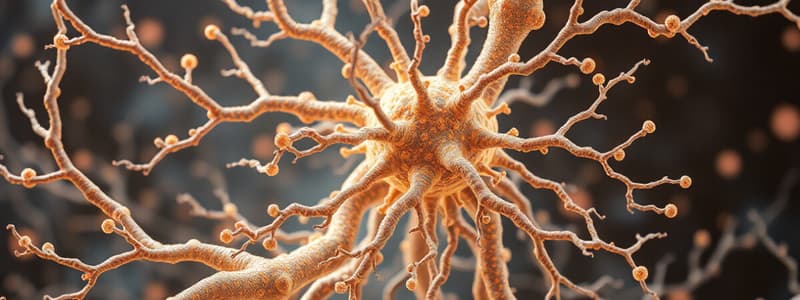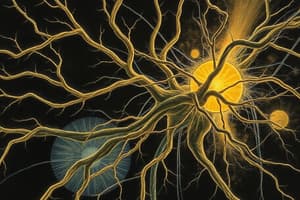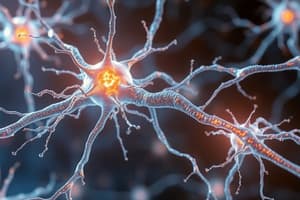Podcast
Questions and Answers
What is the primary function of the myelin sheath in neurons?
What is the primary function of the myelin sheath in neurons?
- To release neurotransmitters
- To receive signals from other neurons
- To insulate the axon and speed up impulse transmission (correct)
- To support the structure of the neuron
Which type of neuron is primarily responsible for transmitting signals from sensory organs to the central nervous system?
Which type of neuron is primarily responsible for transmitting signals from sensory organs to the central nervous system?
- Ependymal neuron
- Sensory neuron (correct)
- Motor neuron
- Association neuron
Which of the following structures is part of the brainstem?
Which of the following structures is part of the brainstem?
- Cerebral cortex
- Thalamus
- Cerebellum
- Medulla (correct)
What is the role of astrocytes in the nervous system?
What is the role of astrocytes in the nervous system?
What distinguishes sensory neurons from motor neurons?
What distinguishes sensory neurons from motor neurons?
What is the effect of the sympathetic nervous system on heart rate?
What is the effect of the sympathetic nervous system on heart rate?
How does the parasympathetic nervous system affect smooth muscle in the digestive tract?
How does the parasympathetic nervous system affect smooth muscle in the digestive tract?
What is the primary effect of the sympathetic nervous system on blood vessels of abdominal organs?
What is the primary effect of the sympathetic nervous system on blood vessels of abdominal organs?
What role does the vagus nerve play in the parasympathetic nervous system?
What role does the vagus nerve play in the parasympathetic nervous system?
What is the effect of the sympathetic nervous system on the smooth muscle of the urinary bladder?
What is the effect of the sympathetic nervous system on the smooth muscle of the urinary bladder?
Flashcards
Neuron component: Axon
Neuron component: Axon
An axon is a long, slender projection of a neuron that transmits electrical impulses away from the cell body.
Neuron type: Sensory neuron
Neuron type: Sensory neuron
Sensory neurons transmit nerve impulses from sensory receptors to the central nervous system.
Neuron type: Motor neuron
Neuron type: Motor neuron
Motor neurons transmit nerve impulses from the central nervous system to muscles or glands.
Brain region: Cerebrum
Brain region: Cerebrum
Signup and view all the flashcards
Neuron component: Dendrite
Neuron component: Dendrite
Signup and view all the flashcards
Sympathetic effect on heart rate
Sympathetic effect on heart rate
Signup and view all the flashcards
Parasympathetic effect on heart rate
Parasympathetic effect on heart rate
Signup and view all the flashcards
Sympathetic effect on bronchi
Sympathetic effect on bronchi
Signup and view all the flashcards
Parasympathetic effect on bronchi
Parasympathetic effect on bronchi
Signup and view all the flashcards
Vagus nerve function regarding digestive tract
Vagus nerve function regarding digestive tract
Signup and view all the flashcards
Study Notes
Neuron Components
- Axon: A long, slender projection of a neuron that transmits electrical impulses away from the cell body.
- Axon Terminals: Small branches at the end of an axon that release neurotransmitters to communicate with other neurons or target cells.
- Cell Body (Soma): The central part of a neuron containing the nucleus and other organelles, responsible for the neuron's metabolic activities.
- Dendrite: Branching extensions of a neuron that receive signals from other neurons.
- Myelin Sheath: A fatty insulating layer around some axons, increasing the speed of impulse transmission.
- Node of Ranvier: Gaps in the myelin sheath along the axon that allow for faster impulse propagation.
Nervous System Cell Types
- Purkinje Neuron: A type of neuron primarily located in the cerebellum, involved in motor coordination and movement.
- Glia: Supporting cells in the nervous system, outnumbering neurons. They provide structural support, insulation, and nourishment.
- Astrocyte: A type of glial cell that provides structural support and regulates the chemical environment of neurons.
- Oligodendrocyte: A type of glial cell that produces myelin in the central nervous system (brain and spinal cord).
- Microglia: A type of glial cell that acts as the immune defense in the central nervous system, removing cellular debris.
- Ependymal: Glial cells that line the ventricles of the brain and produce cerebrospinal fluid.
- Satellite: Glial cells that surround neurons in the peripheral nervous system, providing support.
- Schwann: Glial cells that produce myelin in the peripheral nervous system.
Neuron Types
- Sensory Neuron: Carries sensory information from sensory receptors to the central nervous system. Impulses travel towards the central nervous system.
- Association Neuron (Interneuron): Found in the central nervous system, connecting sensory and motor neurons. Impulses travel between neurons in the CNS.
- Motor Neuron: Transmits signals from the central nervous system to muscles or glands, causing a response. Impulses travel away from the central nervous system.
Central Nervous System Components
- Cerebrum: The largest part of the brain, responsible for higher-level cognitive functions.
- Cerebral Hemispheres: The two halves of the cerebrum.
- Cerebral Cortex: The outer layer of the cerebrum, responsible for complex functions such as thought, language, and perception.
- Frontal Lobe: Located at the front of the brain, responsible for higher cognitive functions.
- Parietal Lobe: Involved in processing sensory information.
- Temporal Lobes: Involved in auditory processing and memory.
- Occipital Lobe: Involved in visual processing.
- Basal Ganglia: Involved in coordinating movement and motor responses.
- Diencephalon: A structure between the cerebral hemispheres and the brainstem.
- Thalamus: A relay station for sensory information, directing it to the appropriate areas of the cerebral cortex.
- Hypothalamus: Involved in regulating many bodily functions like homeostasis and the endocrine system.
- Brain Stem: Connects the cerebrum and cerebellum to the spinal cord, containing vital centers for controlling breathing and heart rate.
- Midbrain: Part of the brainstem, involved in relaying information between the cerebrum and the rest of the nervous system and has some eye and auditory functions.
- Pons: Part of the brainstem, connecting the cerebrum and cerebellum, playing a role in sleep and arousal.
- Medulla Oblongata: Part of the brainstem responsible for vital functions like breathing and heart rate control.
- Cerebellum: Located at the back of the brain, plays a crucial role in coordination, balance, and movement.
- Ventricles: Hollow spaces in the brain filled with cerebrospinal fluid, which cushions the brain and helps remove waste.
Autonomic Nervous System Effects
- Sympathetic Nervous System: Generally prepares the body for "fight-or-flight" responses
- Parasympathetic Nervous System: Generally promotes "rest and digest" functions
- Effect Chart:* (Information needs details on "Effect" to complete the chart)
Cranial Nerves
- Details regarding function, sensory, motor and autonomic components for each cranial nerve are listed.
Studying That Suits You
Use AI to generate personalized quizzes and flashcards to suit your learning preferences.




